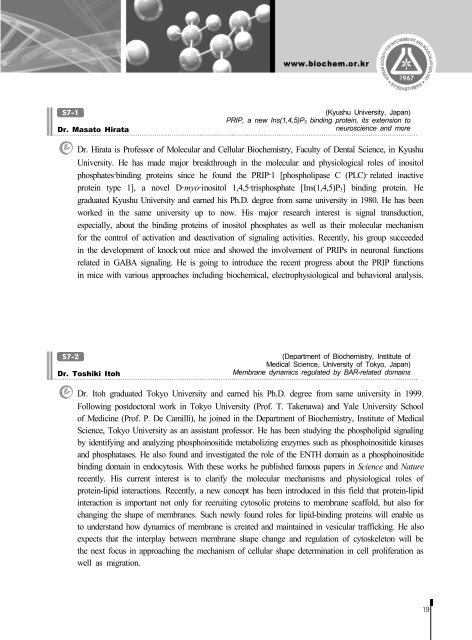Create successful ePaper yourself
Turn your PDF publications into a flip-book with our unique Google optimized e-Paper software.
S7-1Dr. Masato Hirata(Kyushu University, Japan)PRIP, a new Ins(1,4,5)P 3 binding protein, its extension toneuroscience and moreDr. Hirata is Professor of Molecular and Cellular Biochemistry, Faculty of Dental Science, in KyushuUniversity. He has made major breakthrough in the molecular and physiological roles of inositolphosphates‐binding proteins since he found the PRIP‐1 [phospholipase C (PLC)‐ related inactiveprotein type 1], a novel D‐myo‐inositol 1,4,5‐trisphosphate [Ins(1,4,5)P 3 ] binding protein. Hegraduated Kyushu University and earned his Ph.D. degree from same university in 1980. He has beenworked in the same university up to now. His major research interest is signal transduction,especially, about the binding proteins of inositol phosphates as well as their molecular mechanismfor the control of activation and deactivation of signaling activities. Recently, his group succeededin the development of knock‐out mice and showed the involvement of PRIPs in neuronal functionsrelated in GABA signaling. He is going to introduce the recent progress about the PRIP functionsin mice with various approaches including biochemical, electrophysiological and behavioral analysis.S7-2Dr. Toshiki Itoh(Department of Biochemistry, Institute ofMedical Science, University of Tokyo, Japan)Membrane dynamics regulated by BAR-related domainsDr. Itoh graduated Tokyo University and earned his Ph.D. degree from same university in 1999.Following postdoctoral work in Tokyo University (Prof. T. Takenawa) and Yale University Schoolof Medicine (Prof. P. De Camilli), he joined in the Department of Biochemistry, Institute of MedicalScience, Tokyo University as an assistant professor. He has been studying the phospholipid signalingby identifying and analyzing phosphoinositide metabolizing enzymes such as phosphoinositide kinasesand phosphatases. He also found and investigated the role of the ENTH domain as a phosphoinositidebinding domain in endocytosis. With these works he published famous papers in Science and Naturerecently. His current interest is to clarify the molecular mechanisms and physiological roles ofprotein-lipid interactions. Recently, a new concept has been introduced in this field that protein-lipidinteraction is important not only for recruiting cytosolic proteins to membrane scaffold, but also forchanging the shape of membranes. Such newly found roles for lipid-binding proteins will enable usto understand how dynamics of membrane is created and maintained in vesicular trafficking. He alsoexpects that the interplay between membrane shape change and regulation of cytoskeleton will bethe next focus in approaching the mechanism of cellular shape determination in cell proliferation aswell as migration.19







![No 기ê´ëª
(êµë¬¸) ëíì ì íë²í¸ ì¹ì£¼ì ì·¨ê¸í목[ì문] ë¶ì¤ë²í¸ 1 ...](https://img.yumpu.com/32795694/1/190x135/no-eeeeu-e-eii-i-iei-ii-1-4-i-ieiecie-eiei-1-.jpg?quality=85)


